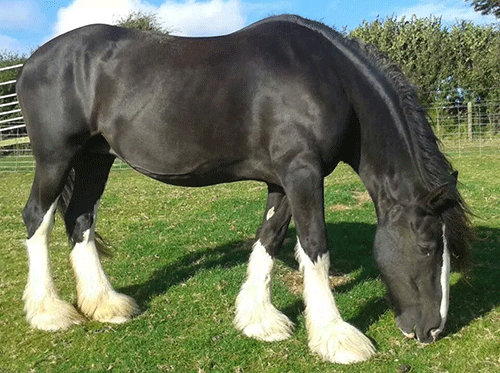The Shire is a British breed of draught horse. It is usually black, bay or grey. It is a tall breed, and Shires have at various times held world records both for the largest horse and for the tallest horse.
The Shire has a great capacity for weight-pulling; it was used for farm work, to tow barges at a time when the canal system was the principal means of goods transport, and as a cart-horse for road transport. One traditional use was for pulling brewer’s drays for delivery of beer, and some are still used in this way; others are used for forestry, for riding (including side-saddle) and for commercial promotion.
The Shire breed was established in the mid-18th century, although its origins are much older. A breed society was formed in 1876, and in 1878, the first stud-book was published. In the late 19th and early 20th centuries, there were large numbers of Shires, and many were exported to the United States.
With the progressive mechanisation of agriculture and of transport, the need for draught horses decreased rapidly, and by the 1960s, numbers had fallen from a million or more to a few thousand. Numbers began to increase again from the 1970s, but the breed is still considered “at risk” by the Rare Breeds Survival Trust.
Outside the United Kingdom, there are stud-books and breed associations in Australia, the United States and Canada.
Shire stallions may be black, bay, brown or grey. They may not be roan or have large amounts of white markings. Mares and geldings may be black, bay, brown, grey or roan. In the UK, stallions may not be chestnut, but the colour is allowed by the US association.
The average height at the withers of grown stallions is about 178 cm (17.2 hands), with a minimum of 173 cm (17.0 h); geldings should stand at least 168 cm (16.2 h), and mares no less than 163 cm (16.0 h). Weight ranges from 850 to 1100 kg for geldings and stallions, with no set standard for mares.
The head of a Shire is long and lean, with large eyes, set on a neck that is slightly arched and long in proportion to the body. The shoulder is deep and wide, the chest wide, the back muscular and short, and the hindquarters long and wide. Not too much feathering is to occur on the legs, and the hair is fine, straight and silky.
The Shire is known for its easy-going temperament. Shires have been identified to be at risk for chronic progressive lymphedema, a chronic progressive disease that includes symptoms of progressive swelling, hyperkeratosis and fibrosis of distal limbs. The disease is similar to chronic lymphedema in humans.
The Shire has an enormous capacity for pulling weight. In 1924, at a British exhibition, a pair of horses was estimated to have pulled a starting load equal to 50 tons, although an exact number could not be determined as their pull exceeded the maximum reading on the dynamometer. Working in slippery footing, the same pair of horses pulled 18.5 tons at a later exhibition.
The largest horse in recorded history was probably a Shire named Mammoth (also known as Sampson), born in 1848. He stood 219 cm high, and his peak weight was estimated at 1 524 kilogrammes. -horsesweekly.com


